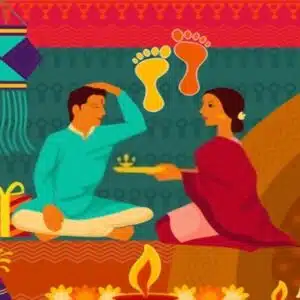
Bhai Dooj, also known as Bhaiya Dooj, is a Hindu festival. This heartwarming festival celebrates the bond between siblings. Bhai Dooj occurs on the second day after Diwali and is widely celebrated in various parts of India. On this day, sisters pray for the well-being and longevity of their brothers while brothers promise to protect them from all evils. Let’s explore the significance of Bhai Dooj and its customs in 100 to 500 words essay on Bhai Dooj for all classes.
Essay on Bhai Dooj 100 Words
Bhai Dooj is a Hindu festival that celebrates the special bond between brothers and sisters. It happens after Diwali and is mainly celebrated in North India. On this day, sisters apply a tilak (vermilion mark) on their brothers’ foreheads. Tilak symbolizes their love and protection. Brothers, in return, give gifts to their sisters as a token of appreciation. Different rituals like Aarti and exchanging sweets and gifts are also performed on this day. These rituals show the love and care sisters have for their brothers.
The festival reminds brothers and sisters of their responsibilities towards each other. Besides all this, Bhai Dooj also reminds us about the importance of family values. In today’s busy life, when everyone is occupied with their daily routines, celebrating festivals like Bhai Dooj brings families together and helps create stronger bonds.
Also Read:
- Makar Sankranti Essay
- Essay on Lohri Festival in English
- Paragraph on Holi
- A Paragraph on Christmas
- Paragraph on Diwali
Paragraph on Bhai Dooj- 150 Words
Bhai Dooj is an auspicious Hindu festival. It is celebrated to honour the unique bond shared between brothers and sisters. This festival brings forth the bond of love between brothers and sisters.
It’s a day when siblings come together to express their affection for each other. They also pray for each other’s well-being. Bhai Dooj is celebrated on the last day of Diwali, which falls on the second lunar day after Amavasya.
On this auspicious occasion, sisters perform various rituals such as the tilak ceremony, offering sweets to them. In return, brothers give gifts to their beloved sisters as a token of appreciation and gratitude.
The significance of Bhai Dooj lies in sibling relationships. The festival not only strengthens the bond between brothers and sisters but also promotes harmony among families. Bhai Dooj teaches us how our loved ones are always there for us through thick and thin.
In conclusion, Bhai Dooj reminds us how we should cherish our siblings every day. They are the ones who will always have our backs no matter what happens in life.
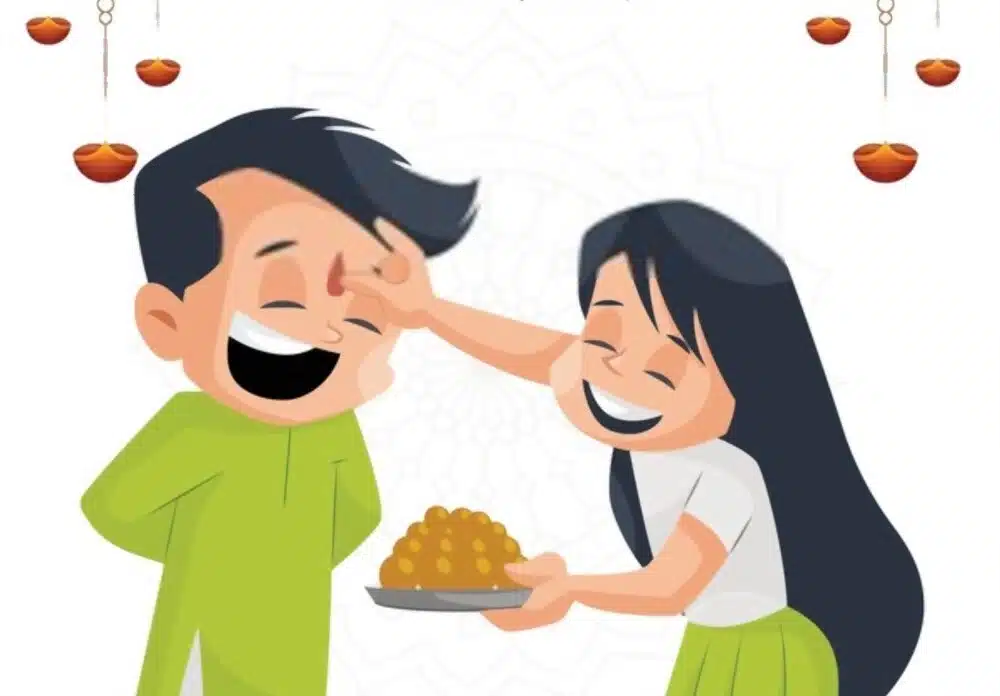
Essay on Bhai Dooj- 200 Words
Bhai Dooj is a significant Hindu festival celebrated with great joy and enthusiasm to honour the everlasting bond between brothers and sisters. This day especially celebrates the bond between brothers and sisters. It also symbolizes their commitment to protecting each other throughout life. The celebration often involves exchanging gifts. Special meals are prepared to mark the occasion. Engaging in activities together helps strengthen their bond.
Bhai Dooj is a beautiful example of how traditions can evolve and adapt to reflect changing societal values. The festival commemorates the occasion when Lord Krishna visited his sister Subhadra after killing the demon Narakasura. Lord Krishna applied tilak (vermilion) on her forehead and blessed her with long life and prosperity. In return, Subhadra offered him sweets and fruits. The tradition of applying tilak on each other’s forehead and exchanging gifts is followed till today.
As we celebrate this special occasion with our loved ones, let us remember the importance of cherishing these bonds throughout our lives. Let us take a moment to appreciate those who have stood by us through thick and thin – our siblings.
Bhai Dooj is a delightful festival that celebrates the eternal bond between brothers and sisters, fostering love, respect, and togetherness among families and communities.
Essay on Bhai Dooj – 300 Words
Bhai Dooj is a joyous occasion that brings family members together. It helps in celebrating love, affection, and togetherness.
Bhai Dooj celebrated on the fifth day of Diwali, follows the grand festival of lights. Sisters eagerly await this special day to express their love and affection towards their brothers. The ritual involves applying a tilak, typically made of vermilion or sandalwood paste, on their brothers’ foreheads. This tilak symbolizes the sister’s blessings and prayers for her brother’s well-being, prosperity, and protection.
The ceremony is not just a symbolic act but a heartfelt gesture that strengthens the bond between siblings. Brothers, in return, shower their sisters with gifts as a token of gratitude and appreciation. These gifts reflect the love, care, and admiration they hold for their sisters, highlighting the importance of this special relationship.
The festival is marked by laughter, joy, and storytelling, creating unforgettable memories and strengthening family ties. This festival symbolizes the fact that no matter how far apart siblings may be, they are still connected through an unbreakable bond of love and affection.
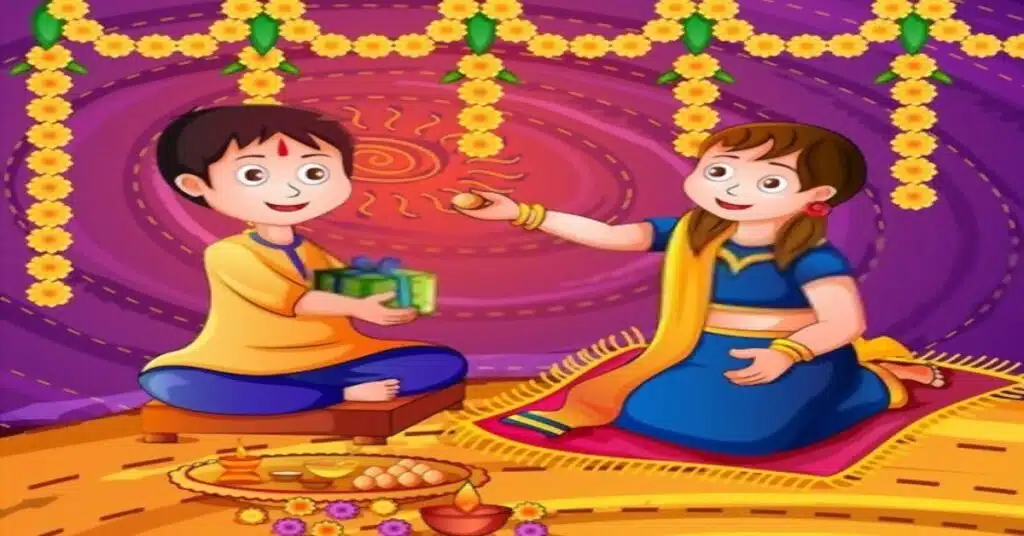
The Bhai Dooj celebrations help contribute to Indian culture in several ways.
- First, it helps strengthen family bonds and relationships.
- Second, it reinforces gender roles and responsibilities within families.
- Third, it promotes love, care, and respect between siblings.
- Fourth, it highlights the importance of traditions and helps preserve cultural values.
- Fifth, Bhai Dooj can be seen as a symbol of India’s diversity. The festival is celebrated by Hindus all across India, regardless of regional or linguistic differences. This shows that despite our differences, we are united by our common culture and traditions.
- Sixth, Bhai Dooj reminds us of the need to take care of our loved ones and treat them with love and respect.
Regardless of age or class, Bhai Dooj is cherished by all. It promotes unity, love, and respect among siblings, fostering a sense of belonging and support. It serves as a reminder of the invaluable role brothers and sisters play in each other’s lives.
Conclusion
Bhai Dooj is a sacred festival that honours the eternal bond between brothers and sisters. Through rituals, gifts, and celebrations, it reinforces the significance of this cherished relationship, bringing families closer and fostering love, harmony, and togetherness.
Essay on Bhai Dooj for all Classes in 100 to 500 Words in English- 400+ words
Bhai Dooj, also known as Bhaubeej or Bhau-Beej, is an important Hindu festival celebrated in many countries including India and Nepal. It falls on the fifth day of Diwali, which is usually in October or November. This festival celebrates the bond between siblings, especially between brothers and sisters. On this auspicious day, sisters pray for their brother’s long life and well-being while the brothers promise to protect their sisters from all harm. Let’s explore the different types of Bhai Dooj celebrations along with their significance and how it is celebrated in many countries.
Introduction to Bhai Dooj
Bhai Dooj, also known as Bhau Beej, is a joyous festival that celebrates the special bond between brothers and sisters. This auspicious occasion falls on the fifth day of Diwali and is celebrated with great enthusiasm throughout India.
Bhai Dooj holds immense significance in Hinduism and reflects the beautiful relationship shared by siblings. Let’s have a closer look at the meaning, history, customs, rituals, and food traditions of Bhai Dooj.
Significance of Bhai Dooj in Hinduism
Bhai Dooj is an important festival celebrated by Hindus all over India and in some parts of Nepal. It falls on the last day of the five-day Diwali festival, which usually occurs in the month of October or November.
The significance of Bhai Dooj lies in its celebration of the bond between brothers and sisters. On this day, sisters pray for their brother’s long life and prosperity, while brothers vow to protect their sisters from harm.
According to Hindu mythology, Lord Krishna visited his sister Subhadra after defeating Narakasura. She welcomed him with a tilak on his forehead and flowers. This practice has been followed ever since as a symbol of love between siblings.
Bhai Dooj also marks the end of Diwali celebrations and the beginning of a new year. It is believed that performing rituals on this day brings good fortune and prosperity into one’s life.
In essence, Bhai Dooj celebrates sibling love and strengthens family bonds. It reminds us to cherish our relationships with our loved ones and always be there for each other through thick and thin.
History and Legends Related to Bhai Dooj
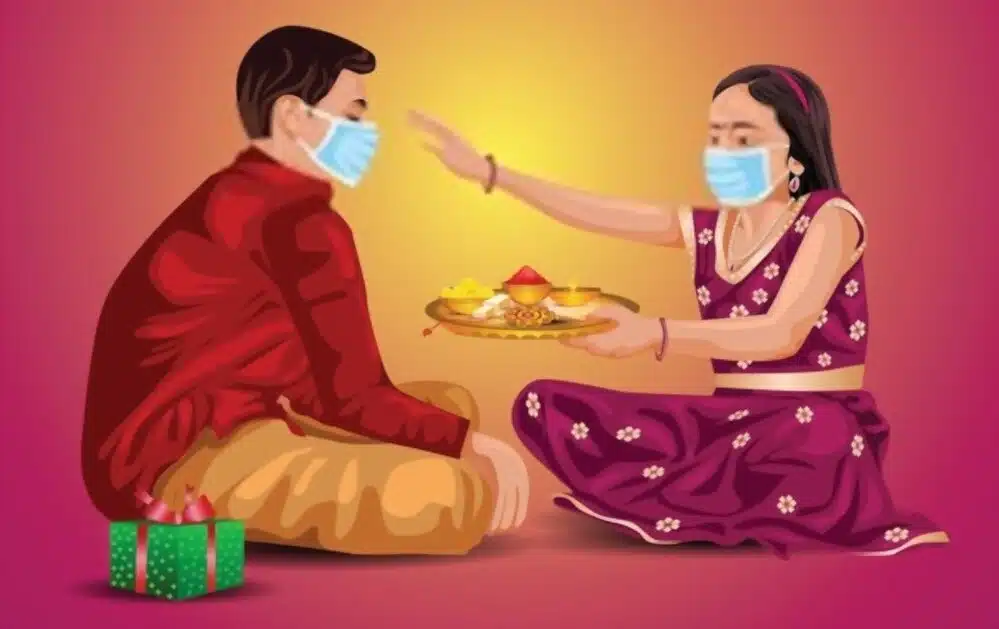
Bhai Dooj is an ancient Hindu festival celebrated on the last day of the five-day Diwali festivities. The history behind this festival goes back to the story of Lord Krishna and his sister Subhadra.
According to legend, after defeating Narakasura, Lord Krishna visited his sister Subhadra who welcomed him with flowers and sweets. She applied tilak or a mark on his forehead as a symbol of love and protection for her brother. This tradition became popular over time and is still followed today during Bhai Dooj celebrations.
Another popular tale associated with Bhai Dooj is that of Yama, the god of death, visiting his sister Yamuna. Upon seeing her brother’s arrival, Yamuna was elated and performed aarti (offering light) in honour of Yama’s visit. Pleased by her hospitality towards him, Yama granted Yamuna a boon that any brother who visits their sisters on this day will receive blessings from him.
These stories illustrate how important sibling relationships are in Hindu culture and highlight the significance of expressing love between brothers and sisters during Bhai Dooj celebrations today.
The Celebration of Bhai Dooj
The celebration of Bhai Dooj is a joyous occasion that marks the bond between brothers and sisters. The festival falls on the fifth day after Diwali, which usually falls in October or November. It’s an important festival among Hindus and is celebrated with great enthusiasm across India.
Rituals and customs are followed during Bhai Dooj to ensure the longevity and prosperity of siblings’ relationships. On this day, sisters apply tilak (a mixture of vermillion, rice grains, and curd) on their brother’s forehead as a mark of protection from evil forces.
After performing the tilak ceremony, sisters offer sweets to their brothers as a symbol of love and affection. Brothers reciprocate by gifting something special to their sisters as a token of appreciation for standing by them through thick and thin.
Traditional food like gujiya (sweet dumplings), laddoos (sweet balls made from flour and sugar), puris (fried bread), and sabzi (vegetable dish) are prepared on this day to add more flavour to the festivities.
Bhai Dooj reinforces family bonding where siblings come together to celebrate each other’s presence in their lives. It’s not just about exchanging gifts or eating delicious food but also about cherishing memories that last forever.
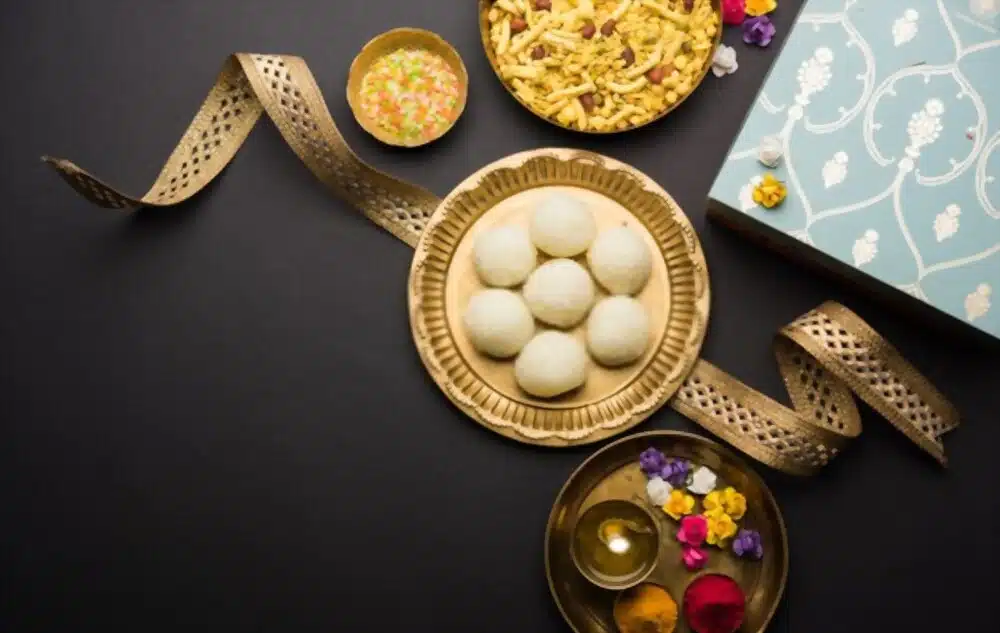
Rituals and Customs Followed during Bhai Dooj
On this day, sisters perform an arti for their brothers by lighting a diya (lamp) in front of them. They put tilak (vermilion powder) on their brother’s forehead and pray for his well-being.
In return, brothers promise to protect their sisters from all harm and shower them with gifts as a token of love. This exchange of vows reflects the trust and affection shared between siblings.
Another significant ritual of Bhai Dooj is the breaking of coconut by the sister. Breaking a coconut symbolizes breaking away from negative energies, purifying one’s thoughts, and embracing positivity.
The festive mood continues throughout the day as families come together to celebrate with food, sweets, laughter, and joy. Sisters prepare delicious meals like malpua or kheer while brothers bring gifts like clothes or gadgets for their beloved sisters.
These rituals make Bhai Dooj special because they create an atmosphere full of love, respect, and gratitude towards each other creating unforgettable memories that last forever.
Traditional Food and Sweets Prepared on Bhai Dooj
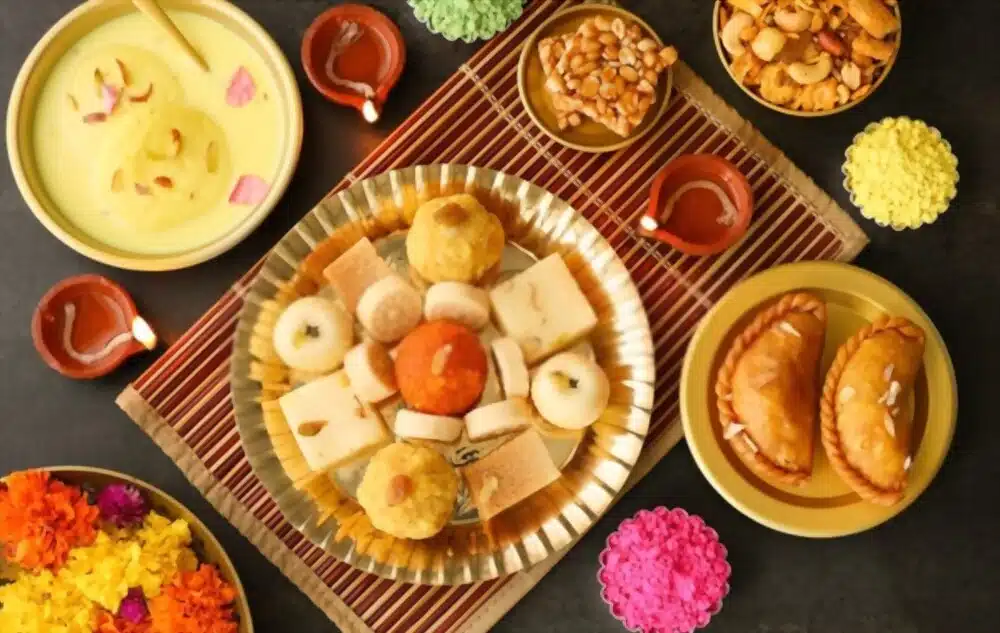
Bhai Dooj is not only a festival of love and affection between siblings but also a time to indulge in delicious traditional food. This auspicious day is marked by the preparation of mouth-watering dishes that are relished by everyone in the family.
One such dish is “Gujia,” which is made from flour, nuts, and khoya. This sweet delicacy has a rich taste and aroma that fills the air with festivity. Another popular sweet prepared on this day is “Besan Ladoo” – a round ball-shaped dessert made from gram flour, ghee, and sugar and garnished with dry fruits.
In addition to sweets, savoury snacks like “Namak Pare” – crispy diamond-shaped noodles seasoned with salt and spices – are also prepared on Bhai Dooj. Families gather around these snacks while engaging in light-hearted conversations about their childhood memories.
The meal on this day includes specialities like “Puri-Sabzi” (deep-fried bread served with vegetable curry) or “Chole Bhature” (a spicy chickpea curry served alongside fried bread). These delectable items make up for an unforgettable culinary experience during the Bhai Dooj festivities.
Bhai Dooj brings people together through its unique blend of cultural significance and culinary delights that add memorable moments to one’s life.
Bhai Dooj: A Celebration of Family Bonding
Bhai Dooj is a festival that celebrates the bond between brothers and sisters. It is not just about exchanging gifts and sweets but also strengthening the family relationship. The festival brings together siblings, cousins, parents, grandparents and other relatives under one roof.
During Bhai Dooj, sisters pray for their brother’s well-being and put ’tilak’ on their foreheads. Brothers in return promise to protect their sisters from all harm. This ritual symbolizes the love and affection shared by siblings since childhood.
Apart from this, families come together to prepare traditional food like ‘samosas’, ‘kachoris’, ‘ladoos’ etc., which are then distributed among everyone present. These moments of togetherness strengthen familial bonds even further.
In recent times, Bhai Dooj has become an occasion for a reunion as many siblings who live apart get a chance to meet each other after a long time. With changing lifestyles and busy schedules, festivals like Bhai Dooj serve as reminders of the importance of family bonding.
Bhai Dooj serves as a celebration of sibling love while also offering opportunities for strengthening familial ties among extended family members too!
How Bhai Dooj Strengthens the Relationship between Brothers and Sisters
Bhai Dooj is a festival that holds immense significance for the strengthening of the bond between brothers and sisters. It marks a day when siblings come together to celebrate their love and affection towards each other.
The rituals and customs followed during Bhai Dooj are aimed at enhancing this special relationship. The sister performs an Aarti of her brother, putting tilak on his forehead as a sign of good luck while praying for his well-being and longevity.
In return, the brother promises to protect his sister from all harm throughout her life. This promise symbolizes the unconditional love and care that exists in sibling relationships.
The celebrations also include exchanging gifts between siblings, which further strengthens their bond of affection. These gifts serve as a token of appreciation for each other’s presence in their lives.
Through such rituals, Bhai Dooj fosters mutual respect and understanding between brothers and sisters. It teaches them to cherish one another’s company through thick and thin.
In contemporary times, even though families may be scattered across different parts of the world, technologies like video calls have enabled us to remain connected with our loved ones on such auspicious occasions.
Bhai Dooj remains an essential celebration that helps promote family bonds built on trust & loyalty among siblings irrespective of age or gender differences.
Contemporary Trends in Celebrating Bhai Dooj
Over the years, Bhai Dooj celebrations have evolved to accommodate contemporary trends. While traditional rituals and customs remain unchanged, modern-day siblings add their own unique twist to the festivities.
One such trend is the use of technology in celebrating Bhai Dooj. With families living far apart, video calls and social media platforms serve as a means for brothers and sisters to connect virtually on this special day. It’s heartwarming to see siblings exchange heartfelt wishes despite being miles away from each other.
Another emerging trend is the gifting culture associated with Bhai Dooj. Siblings today are more likely to give thoughtful presents that align with their brother or sister’s interests rather than just sweets and money envelopes. This gesture adds a personal touch to the celebration, making it all the more memorable.
In recent times, eco-friendly celebrations have also gained popularity during Bhai Dooj. Many people opt for sustainable ways of decorating their homes using recycled materials while others choose environmentally safe products for gifts instead of single-use plastic items.
These contemporary trends demonstrate how younger generations are adapting traditional festivals like Bhai Dooj into modern-day life without losing sight of its essence – bonding between siblings that transcends time and distance.
Conclusion: The Timeless Relevance of Bhai Dooj
Bhai Dooj is a festival that celebrates the bond between brothers and sisters. It brings families together to strengthen their relationships through rituals, customs, and traditional foods. The festival has taken on contemporary trends as well, but its timeless relevance remains intact.
As Hindus around the world celebrate Bhai Dooj this year, let’s remember how much our siblings mean to us and appreciate the unique relationship we share with them. Happy Bhai Dooj to everyone!
FAQs-
1) What is the story behind Bhai dooj?
The story behind Bhai Dooj varies across different regions of India, but one popular legend associated with this festival is the story of Lord Yama, the God of Death, and his sister Yamuna.
According to the legend, Lord Yama visited his sister Yamuna after a long period of separation. Overwhelmed with joy, Yamuna performed an aarti (a ritual of waving lamps) and applied a tilak on her brother’s forehead as a mark of love and protection. In return, Lord Yama gave his sister a special blessing and gift. Touched by their reunion and the sisterly affection, Lord Yama declared that any brother who receives an aarti and tilak from his sister on this day will be blessed with happiness, prosperity, and protection.
This story has led to the tradition of sisters performing aarti and applying tilak on their brothers’ foreheads during Bhai Dooj. It symbolizes the sisters’ love, prayers, and wishes for their brothers’ well-being and safety. In return, brothers give gifts to their sisters as a token of appreciation for their affection and support.
The story of Lord Yama and Yamuna serves as a reminder of the significance of sibling bonds and the importance of expressing love and gratitude for each other. Bhai Dooj, therefore, celebrates the eternal bond between brothers and sisters and reinforces the values of love, respect, and togetherness.